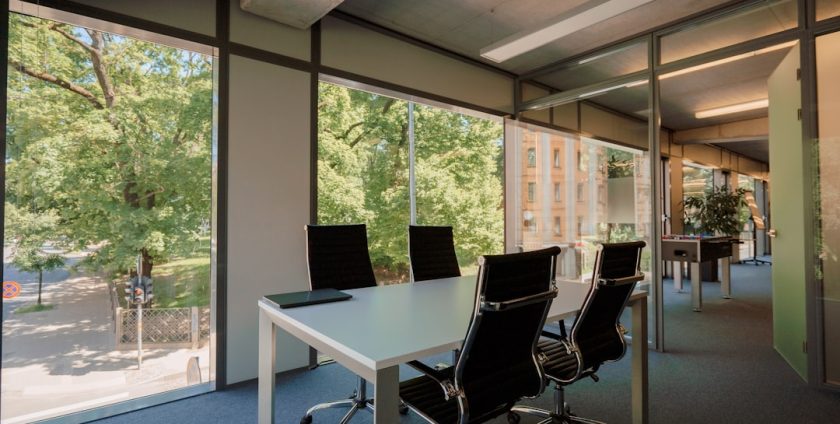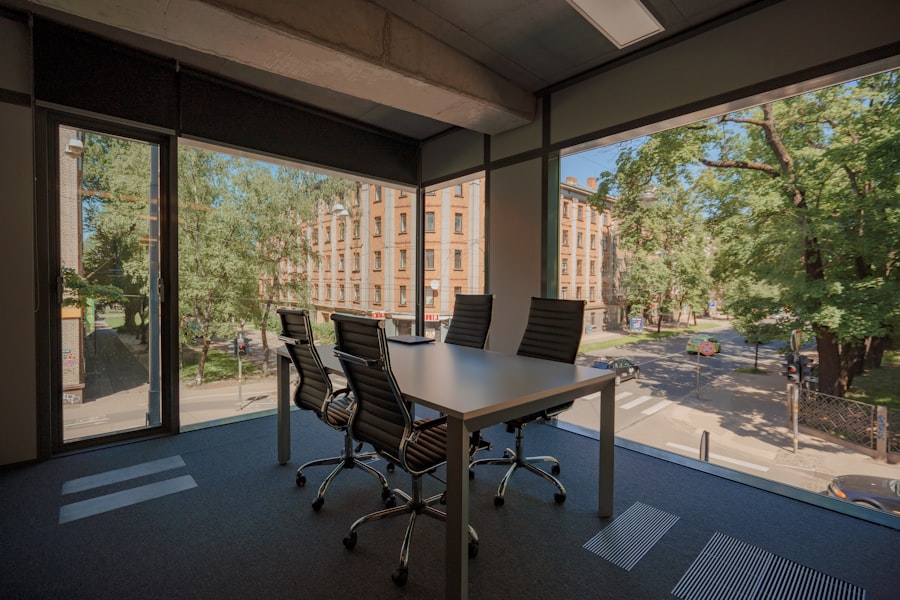
- By: admin
- Category: Commercial Floor Cleaning Machines
- 0 comment
In the modern business landscape, the office environment plays a pivotal role in shaping employee experiences and influencing overall productivity. As organisations strive to create spaces that foster collaboration, creativity, and well-being, the significance of every element within the office becomes increasingly apparent. Among these elements, flooring often goes unnoticed, yet it serves as the foundation upon which the entire workspace is built.
This article delves into the multifaceted role of flooring in office environments, exploring its impact on comfort, functionality, and aesthetics while providing insights for facility managers and contract cleaners alike. Understanding the nuances of office flooring is essential for building managers and facility managers who aim to create an inviting atmosphere. The right flooring not only enhances the visual appeal of a workspace but also contributes to employee satisfaction and productivity.
As we navigate through the various aspects of office flooring, we will uncover how thoughtful choices can lead to a more efficient and harmonious work environment. Please feel free to get in touch with us through our Contact Us page.
Summary
- The office environment plays a crucial role in employee productivity and well-being.
- The choice of flooring in the office can significantly impact the overall atmosphere and functionality of the workspace.
- Selecting the right flooring for your office involves considering factors such as durability, maintenance, and design aesthetics.
- A comfortable and functional workspace is essential for promoting employee satisfaction and productivity.
- The right flooring can enhance productivity by providing a safe, clean, and visually appealing environment for employees to work in.
Importance of Flooring in Office Environment
Flooring is often one of the most overlooked aspects of office design, yet it plays a crucial role in establishing the overall atmosphere of a workspace. The type of flooring selected can significantly influence factors such as noise levels, comfort, and even employee health. For instance, hard surfaces like tiles or polished concrete may contribute to a more professional appearance but can also amplify sound, creating a distracting environment.
Conversely, softer flooring options like carpets can absorb sound and provide a warmer feel but may require more maintenance to keep them looking pristine. Moreover, flooring can impact safety within the office. Slip-resistant surfaces are essential in high-traffic areas such as entrances and kitchens to prevent accidents.
In industrial settings, where heavy machinery is often present, durable flooring that can withstand wear and tear is paramount. Therefore, understanding the specific needs of your office environment is vital when selecting flooring that not only meets aesthetic preferences but also prioritises safety and functionality.
Choosing the Right Flooring for Your Office

Selecting the appropriate flooring for an office environment involves careful consideration of various factors, including foot traffic, maintenance requirements, and design preferences. For high-traffic areas, such as reception desks or meeting rooms, materials like vinyl or laminate may be ideal due to their durability and ease of cleaning. These options can withstand heavy use while maintaining their appearance over time, making them a practical choice for busy workplaces.
In contrast, quieter spaces such as private offices or break rooms may benefit from carpet tiles or plush carpets that provide comfort underfoot and help reduce noise levels. Additionally, carpet tiles offer flexibility; if one tile becomes stained or damaged, it can be replaced without the need to overhaul the entire floor. This adaptability is particularly advantageous for facility managers who must balance aesthetics with practicality.
Creating a Comfortable and Functional Workspace
A well-designed office should prioritise both comfort and functionality, and flooring plays a significant role in achieving this balance. Ergonomics should be at the forefront of any design decision; for instance, standing desks have become increasingly popular in modern offices. However, standing for prolonged periods can lead to discomfort without appropriate flooring solutions.
Anti-fatigue mats or cushioned flooring can alleviate pressure on employees’ feet and joints, promoting better health and productivity. Furthermore, the layout of an office can be enhanced by strategic flooring choices. Using different materials or colours to delineate areas can help guide employees through the space while creating distinct zones for collaboration or quiet work.
This approach not only improves functionality but also contributes to an aesthetically pleasing environment that employees are proud to be part of.
Enhancing Productivity with the Right Flooring
The connection between flooring and productivity is often underestimated. Studies have shown that employees are more productive in environments that are comfortable and visually appealing. For example, natural wood or stone flooring can create a calming atmosphere that encourages focus and creativity.
In contrast, overly bright or harsh flooring materials may lead to distractions and discomfort. Moreover, incorporating biophilic design elements—such as natural materials or patterns inspired by nature—can further enhance employee well-being. Research indicates that exposure to natural elements can reduce stress levels and improve cognitive function.
By selecting flooring that aligns with these principles, facility managers can create an environment that not only looks good but also supports employee performance.
Maintaining a Clean and Safe Office Environment

Maintaining cleanliness in an office environment is paramount for both health and safety reasons. The choice of flooring can significantly impact how easily spaces can be kept clean. For instance, hard surfaces like vinyl or tile are generally easier to maintain than carpets, which can trap dust and allergens if not regularly cleaned.
Facility managers should consider the cleaning protocols required for each type of flooring when making their selections. Additionally, regular maintenance is essential to ensure that flooring remains safe for employees. This includes routine inspections for wear and tear, as well as immediate attention to spills or stains that could pose slip hazards.
Implementing a comprehensive cleaning schedule tailored to the specific needs of your flooring type will not only prolong its lifespan but also contribute to a healthier workplace.
Incorporating Design and Aesthetics into Your Office Flooring
While functionality is crucial in selecting office flooring, aesthetics should not be overlooked. The visual appeal of an office can significantly influence employee morale and client perceptions. Flooring options today come in a myriad of styles, colours, and textures that allow businesses to express their brand identity while creating an inviting atmosphere.
For example, an innovative tech company might opt for vibrant coloured carpets or unique vinyl patterns that reflect their creative ethos. In contrast, a law firm may choose elegant hardwood or polished concrete to convey professionalism and sophistication. By aligning flooring choices with brand values and workplace culture, organisations can create spaces that resonate with both employees and clients alike.
Creating a Positive and Inviting Office Environment
In conclusion, the importance of flooring in an office environment cannot be overstated. From enhancing comfort and functionality to promoting safety and aesthetics, the right flooring choices have far-reaching implications for employee satisfaction and productivity. Facility managers and contract cleaners must recognise the integral role that flooring plays in shaping workplace experiences.
By investing time and resources into selecting appropriate flooring solutions tailored to specific needs, organisations can create positive environments that foster collaboration and innovation. Ultimately, a well-considered approach to office flooring not only enhances the physical space but also contributes to a thriving organisational culture. FAQ Section: 1.
What types of flooring are best for high-traffic areas in an office?
– Durable options such as vinyl or laminate are ideal for high-traffic areas due to their resilience and ease of maintenance. 2. How often should office flooring be cleaned?
– The frequency of cleaning depends on the type of flooring; however, regular maintenance should be conducted at least weekly to ensure cleanliness and safety.
3. Can carpet tiles be used in commercial settings?
– Yes, carpet tiles are suitable for commercial settings as they offer flexibility in maintenance; damaged tiles can be replaced individually without needing to replace the entire carpet. 4.
What are some eco-friendly flooring options for offices?
– Sustainable options include bamboo flooring, cork tiles, or carpets made from recycled materials that contribute to a greener workplace. 5. How does flooring impact employee productivity?
– Comfortable and aesthetically pleasing flooring can enhance focus and creativity while reducing distractions, ultimately leading to increased productivity among employees.
FAQs
What are the benefits of improving the office environment?
Improving the office environment can lead to increased productivity, higher employee satisfaction, better health and well-being, and a more positive company culture.
How can the office environment be improved starting from the ground up?
Improving the office environment starting from the ground up can involve upgrading flooring materials, implementing ergonomic furniture, enhancing lighting, and introducing indoor plants for better air quality.
What are some flooring options that can improve the office environment?
Flooring options that can improve the office environment include carpet tiles for noise reduction, vinyl or linoleum for easy maintenance, and hardwood for a more sophisticated look.
How can ergonomic furniture improve the office environment?
Ergonomic furniture such as adjustable desks and chairs can improve the office environment by promoting better posture, reducing the risk of musculoskeletal disorders, and increasing overall comfort for employees.
What role does lighting play in improving the office environment?
Proper lighting in the office environment can reduce eye strain, improve mood and energy levels, and enhance overall visibility for tasks. Natural light and adjustable lighting options are particularly beneficial.
How can indoor plants contribute to a better office environment?
Indoor plants can improve the office environment by purifying the air, reducing stress, and adding a touch of nature to the workspace. They can also contribute to a more aesthetically pleasing and calming atmosphere.
